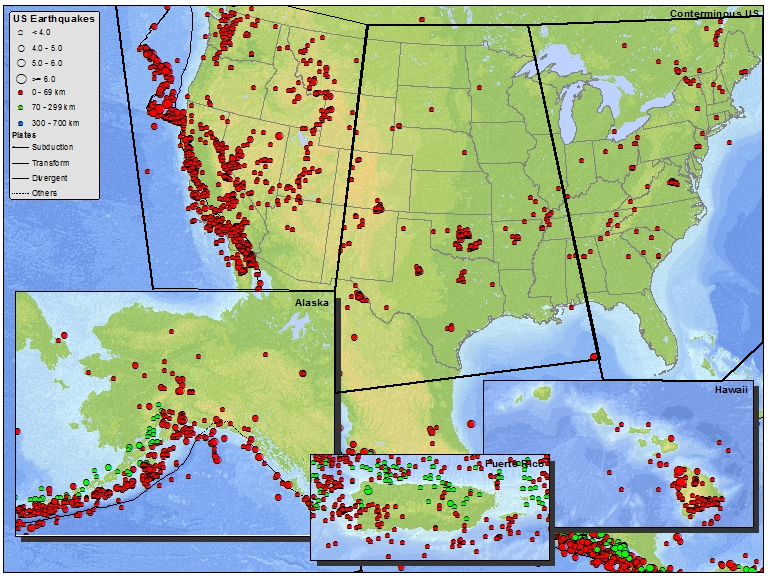Large, distant earthquakes may cause smaller quakes at U.S. drilling sites

From the late 1960s until 2000, there were only 21 earthquakes a year with a magnitude greater than 3 in central and eastern United States. But from 2010-2012, the region experienced over 300.
In a paper in Science, researchers think they may have found a reason for the uptick—water being injected deep into the earth. Wastewater wells from hydraulic fracturing and mineral exploration operations have proliferated throughout the region. Other papers have already shown that those activities could cause earthquakes. Drilling makes the ground in those areas more vulnerable to seismic stresses, including from violent, large-scale quakes in places as far away as Chile and Japan.
.jpg)
Seismicity of the United States Image Credit: USGS
From the New York Times:
When waste water is injected into rock formations, it increases pressure enough that long-dormant faults are primed to slip once again, shaking the earth. Dr. van der Elst suggested that small stresses from the passing seismic waves in effect “squeezed” the rocks at the injection sites, raising the pressure past the tipping point so that the faults slip and the earth shakes.
Some of these areas had even stronger quakes months later — notably Prague, Okla., where a 5.7 quake occurred in 2011 — a further indication that the faults had reached a tipping point.
But fossil fuel drilling sites aren’t the only places where humanity is running into a rocky dilemma. In another paper from the same issue of Science, geologists at the Salton Sea geothermal field also found that sites where water was injected and extracted from the ground were correlated with increased seismicity.
The USGS called for more data, noting that the current information reported to regulatory agencies is spotty at best:
One risk-management approach highlighted in [USGS geophysicist and author of a review of the Science paper] Ellsworth’s article involves the setting of seismic activity thresholds for safe operation. Under this “traffic-light” system, if seismic activity exceeds preset thresholds, reductions in injection would be made. If seismicity continued or escalated, operations could be suspended.
The current regulatory framework for wastewater disposal wells was designed to protect drinking water sources from contamination and does not address earthquake safety. Ellsworth noted that one consequence is that both the quantity and timeliness of information on injection volumes and pressures reported to the regulatory agencies is far from ideal for managing earthquake risk from injection activities.
Thus, improvements in the collection and reporting of injection data to regulatory agencies would provide much-needed information on conditions potentially associated with induced seismicity. In particular, said Ellsworth, daily reporting of injection volumes, and peak and average injection pressures would be a step in the right direction, as would measurement of the pre-injection water pressure and tectonic stress.
Source: SmithsonianMag
Featured image: USGS

hmmmm . . .
http://lasinkhole.wordpress.com/2013/07/13/map-showing-the-7-7-quake-the-landslide-and-ship-shoal-oil-leak/